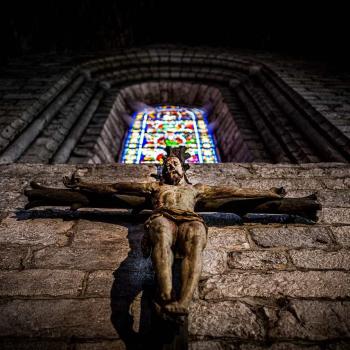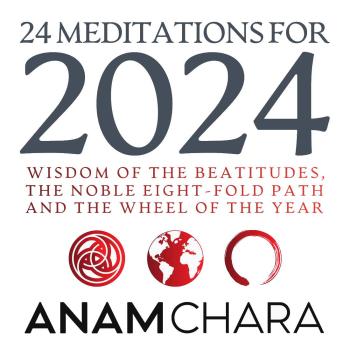
Sometimes people will ask me if “contemplation” and “mysticism” are synonyms.
I admit: I often use the words interchangeably. But if they meant exactly the same thing, then one word would be redundant, right?
So perhaps it’s worth taking a moment to consider how contemplation and mysticism describe two slightly different dimensions of spirituality. Different, but very closely related.
Mysticism
Let’s begin with the more difficult of the two words. Mysticism refers to the dimension of spirituality which transcends human language and reason: it fundamentally cannot be put into words. Mysticism, after all, is related to mystery.
It is the spirituality of the mystery of God.
Mysticism points to a place beyond the limits of human logic and reason. It is not irrational — a better word to describe would be transrational.
Mystics use language such as “unknowing,” “dark night of the soul,” “dazzling darkness,” and “the abyss” to try to put into words what is ultimately unsayable: to attempt to speak of the mystery, as well as the mystery of humanity’s response to the Divine mystery. For mystical language does not stop with the notion that God is unknowable — rather, it follows the audacious language of Jesus and the New Testament writers to assert that this unknowable, unsayable God is present in our lives, is poured into our hearts, that we abide in this God and this God abides in us, in this God we live and move and have our being, and indeed, we are partakers of the Divine nature.
So God is not the only mystery in mysticism. We human beings are also part of the mystery, indeed you could say that we are one with the mystery, not by any action of our own, but entirely by the grace and initiative of God.
Is mysticism, then, an experience of God? That is a common way of understanding mysticism, but I think it oversimplifies things. There are so many problems when it comes to experience (is an experience truly from God, or merely a projection of our egos? But what about the idea that God is hidden — a recurring Biblical theme — which suggests that an essential feature of this God-as-mystery is that God’s presence and union in our lives transcends all human experience?). So if we dare to say that mysticism concerns the experience of God, we have to be honest and acknowledge that sometimes God is inexperienceable — and sometimes what we think of as “an experience of God” might in fact be nothing more than ego-fulfillment.
So I think a firmer foundation is to say that mysticism is a strategy for understanding that which cannot be understood. This might include experience, but it is not limited to experience. It can also include a way of talking/writing about God (mystical discourse, or mystical theology), a way of behaving in response to God — both on a personal level (spiritual practice) and on a communal level (liturgical and sacramental rites).
Which brings us to contemplation.
Contemplation
To make sense of contemplation, let’s look at the word’s etymology, along with a contemporary definition.
First, the background of the word, as found on the Online Etymology Dictionary:
contemplation (n.)
c. 1200, contemplacioun, “religious musing,” from Old French contemplation and directly from Latin contemplationem (nominative contemplatio) “act of looking at,” noun of action from past-participle stem of contemplari “to gaze attentively, observe; consider, contemplate,” originally “to mark out a space for observation” (as an augur does), from assimilated form of com–, here probably an intensive prefix (see com-), + templum “area for the taking of auguries” (see temple (n.1)).
And now, the glossary of the Catechism of the Catholic Church:
CONTEMPLATION: A form of wordless prayer in which mind and heart focus on God’s greatness and goodness in affective, loving adoration; to look on Jesus and the mysteries of his life with faith and love.
Contemplation, therefore is a way of seeing. It is the act of gazing into the mystery of God, an act beyond words or logical expression.
Thus, the two essential elements of contemplation are silence (it’s “wordless) and prayer. Granted, there is a secular dimension of contemplation, but that is not the focus of this post (or this blog). We often use the compound “contemplative prayer” to emphasize that, in a spiritual sense, contemplation is relational — it’s not just gazing into wisdom, or beauty, or beatitude (although it could be all of those things), but essentially gazing into the eyes of God.
This is why the Catechism uses language of love and adoration.
Contemplation is a response to God’s love. We love because God first loved us; and contemplative prayer is the prayer of love responding to Love.
Traditionally, Christian mystical theology has seen contemplation as a grace: in other words, contemplation is not something we do so much as something we receive from God by grace. This is why the official teaching of centering prayer is that it is a method of preparing for contemplation. We cannot will ourselves into contemplation; rather, we may choose to dispose ourselves to the gift of contemplation, consenting to it with silent prayer practices like centering prayer or other forms of meditation.
Therefore, much of the language of contemplation also includes the quality of waiting. “For God alone my soul in silence waits,” affirms Psalm 62. This is the heart of contemplative practice.
Silence
Another way of thinking about the relationship between mysticism and contemplation is considering the relationship between being and doing. Contemplation is what mystics do — or what they hope to do, by grace. Contemplation, therefore, is a doorway into mysticism.
Mysticism is a dimension of spirituality. Contemplation is a dimension of prayer. What unites them is that they both call us beyond grammar and syntax into the loving freedom of silence.
Since mysticism cannot be put into words, and contemplation likewise involves a wordless gaze of love, silence is the essential nutrient for anyone seeking to walk the path of mystical or contemplative prayer.
And since, at least in terms of Christian theology, both mystical spirituality and contemplative prayer are understood to be graces, gifts from God, these things therefore are best approached in an indirect way.
The path to contemplation is the path of silent prayer, of practices like centering prayer or lectio divina or the Jesus Prayer. The path to mysticism is the path of embracing the Divine mystery, through silence, prayer, liturgy and the sacraments, and immersion in mystical theology.
Since silence and prayer are the portals into mysticism, as well as the path of disposing ourselves to contemplation, it only makes sense that we see mysticism and contemplation as deeply related, and indeed almost interchangeable.
Almost — but not quite identical. Contemplation is a way of seeing (and therefore, a way of knowing). Mysticism is a way of being.
Enjoy reading this blog?
Click here to become a patron.














